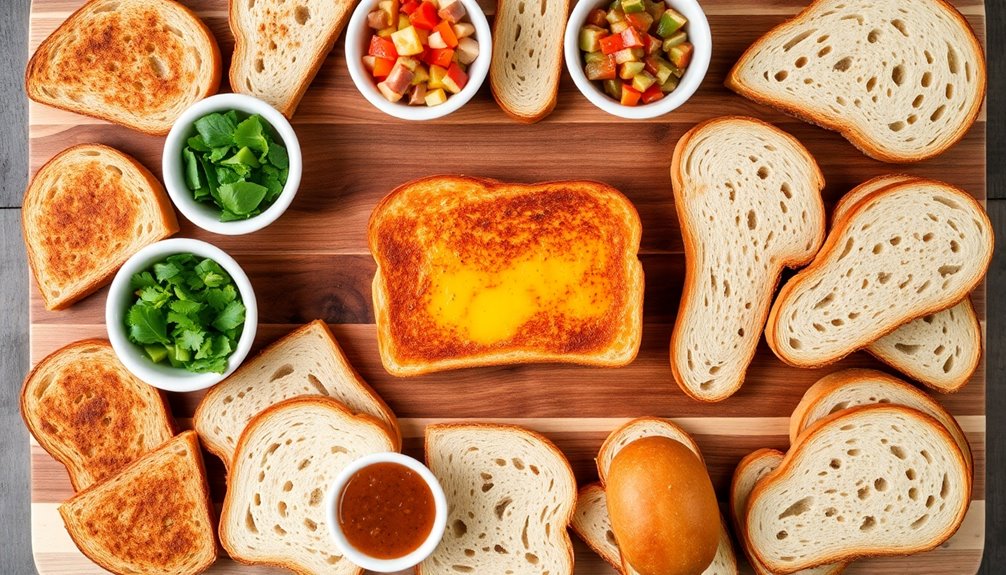You can make the most of every slice of bread in your pantry. Transform stale bread into delicious French toast, or whip up a comforting bread pudding. Try making savory strata or crunchy croutons to elevate your salads. Mix leftover bread into hearty casseroles or stuff it into veggies for a filling meal. Don't forget about using bread to soften brown sugar or create homemade bread chips for snacking. By getting creative, you minimize waste and save money. Want to discover more inventive ways to use bread and maximize your kitchen efforts? There's plenty more to explore!
French Toast Innovations
French toast innovations often bring a delightful twist to your breakfast routine. If you've got leftover bread, you can whip up a variety of French toast recipes that elevate this comfort food to new heights.
For a crowd-pleaser, try the Blueberry French Toast, which combines cream cheese and blueberries for a dessert-like experience. It's perfect for brunch gatherings and requires minimal prep time. Using a budgeting app can help you track grocery spending while you enjoy this delicious dish. Many of these apps, like YNAB(YNAB), can provide you with insights into your spending habits.
If you're looking for something indulgent, the Chocolate French Toast features a hidden chocolate layer that appeals to both kids and adults alike.
For those special occasions, consider making Baked French Toast. It's a make-ahead option that serves eight and can be prepared in just 60 minutes.
Don't forget about the convenience of French Toast Sticks! They're easy to freeze and great for busy mornings. With 1-1/2 dozen sticks yielding just 183 calories per three, you can satisfy cravings without guilt.
Finally, the simple Vanilla French Toast can serve as a base for waffles and pancakes, making it versatile. Using budget apps can help you manage your grocery expenses effectively, promoting financial discipline as you explore these creative recipes.
Delicious Bread Pudding
There's something incredibly comforting about bread pudding, a dessert that transforms leftover bread into a rich and satisfying treat. If you've got stale bread lying around, this is your chance to use it up creatively. Utilizing coupon codes can make the ingredients more affordable, allowing you to indulge without overspending.
The beauty of bread pudding lies in its versatility; you can whip it up sweet or savory, depending on your cravings. To start, combine your leftover bread with a mixture of eggs, milk, and sugar to create that luscious custard-like base. Feel free to enhance your bread pudding with fruits, nuts, or even chocolate for an extra touch of indulgence.
A favorite variation you might want to try is Butterscotch-Pecan Bread Pudding, where the sweetness of butterscotch pairs perfectly with crunchy pecans. Top it off with whipped cream for an unforgettable dessert. Additionally, incorporating this recipe into your meal planning can help you develop better financial management practices in your kitchen.
Baking bread pudding takes about 60 minutes, making it a fantastic option for family gatherings or special occasions. Not only do you get a delicious treat, but you also embrace frugal cooking by minimizing waste. Recognizing the value of using up leftovers can reinforce positive financial habits, as it aligns with the principles of budgeting for financial goals.
Savory Strata Recipes
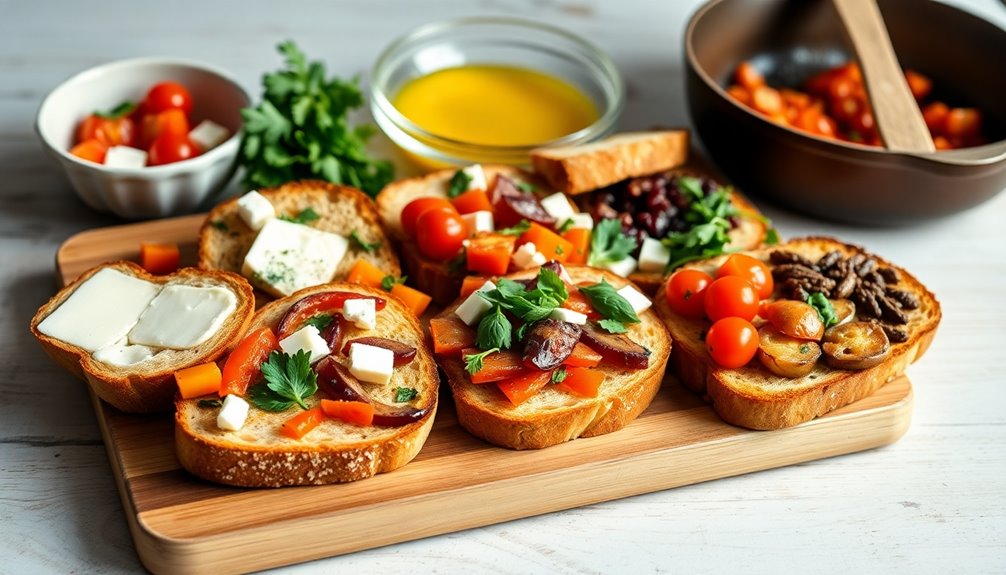
Savory strata recipes are perfect for easy make-ahead meals that save you time and effort. You can mix and match ingredients like meats, cheeses, and veggies to create a dish that suits your taste. Regular reviews of savings and investments can enhance your overall financial health, allowing you to allocate more funds towards enjoying delightful meals. Additionally, automated investment management tools can help you track your finances more effectively, enabling you to save for those special occasions. Whether you're hosting a brunch or looking for a weeknight dinner, these versatile recipes will impress your guests and satisfy your cravings. Additionally, incorporating AI-driven tools can help you discover unique flavor combinations based on your preferences.
Easy Make-Ahead Strata
If you're looking for a delicious and stress-free meal option, an easy make-ahead strata might be just what you need. This savory dish layers cubed stale bread with eggs, milk, cheese, and your choice of fillings like vegetables or meats.
It's an excellent way to use up day-old bread, and you'll typically need about 10-12 cups for a hearty recipe.
To prepare, simply assemble the strata the night before your brunch gathering. Mix your ingredients, pour them over the bread, and let it soak in the refrigerator overnight.
The next day, all you have to do is pop it in the oven, allowing the flavors to meld beautifully while you relax with your guests.
Savory strata is perfect for serving 8 to 12 people, making it ideal for family meals or larger gatherings. You can customize it with different cheeses, herbs, and spices to suit your taste.
Plus, with around 198 calories and 13g of protein per serving, it's a filling dish that won't weigh you down.
Versatile Ingredient Combinations
When crafting a delicious strata, the possibilities are endless thanks to the wide range of ingredient combinations you can use. You can easily transform stale or leftover bread into a savory dish that minimizes food waste while satisfying your family or guests.
For instance, consider a mustard ham strata, where layers of bread, ham, cheese, and a creamy custard mixture come together for a hearty brunch option.
If you're in the mood for something a bit spicier, try a cheddar and chorizo strata. This dish allows you to mix and match cheeses or even go meatless, ensuring it's adaptable to whatever you have on hand.
Another comforting choice is the scalloped chicken casserole, featuring tender chicken and layers of bread, perfect for a cozy meal.
With these versatile recipes, you've got the freedom to experiment and create a dish that suits your taste while ensuring none of that precious bread goes to waste.
Creative Salad Ideas
When it comes to salads, bread can be a game changer.
You can whip up delicious Panzanella variations using seasonal ingredients, or transform leftover bread into homemade croutons that add a crunchy twist. Additionally, incorporating expense tracking tools in your meal planning can help you manage your food budget effectively. For instance, using apps like receipt scanning can streamline your expense tracking and ensure you stay within your budget while enjoying creative salad ideas. Moreover, automating expense tracking allows you to focus more on your culinary creativity rather than on managing your finances.
Let's explore how to make your salads more exciting and satisfying with these creative ideas!
Panzanella Salad Variations
Panzanella salad is a delightful way to celebrate seasonal produce while making good use of leftover bread. This traditional Italian dish combines crusty bread with ripe tomatoes, cucumbers, and onions, all drizzled with a simple olive oil and vinegar dressing.
You can easily adapt the salad to suit the seasons. For a winter twist, try adding roasted vegetables like cauliflower or radishes, which create a mix of sharp and mellow flavors.
To elevate your Panzanella, consider tossing in olives, capers, or a handful of fresh herbs like basil. These additions not only enhance the flavor profile but also contribute a revitalizing taste that complements the juicy vegetables.
The slightly stale texture of leftover bread is perfect for soaking up the dressing and juices, ensuring every bite is flavorful and satisfying.
Don't hesitate to experiment with different ingredients based on your personal preferences. Whether you stick to the classic version or get creative with seasonal produce, Panzanella salad is a versatile dish that showcases the best of what you have on hand while reducing food waste.
Enjoy this simple yet delicious way to make the most of your leftover bread!
Homemade Crouton Tips
Transforming leftover bread into homemade croutons can elevate your salads to a whole new level. Start by cutting stale bread into cubes—this type of bread is perfect because it holds up better during the toasting process. Toss the cubes with olive oil, garlic powder, and your choice of herbs. For a unique twist, consider adding Parmesan cheese, Italian seasoning, or smoked paprika to enhance flavor.
Preheat your oven to 350°F and spread the seasoned bread cubes on a baking sheet. Bake for 10-15 minutes until they're golden and crispy. The result? Delicious homemade croutons that add texture and depth to your salads. They work especially well in hearty salads like Caesar or panzanella, where their crunch complements fresh ingredients beautifully.
If you have any leftover croutons, store them in an airtight container at room temperature for up to a week. For longer shelf life, you can freeze them, preserving their freshness for later use.
With these simple steps, you'll never waste a slice of bread again, making your salads even more delightful with every bite!
Seasonal Ingredient Pairings
Elevating your salads with seasonal ingredients is a fantastic way to enhance flavor while reducing food waste. One delightful option is a Panzanella salad, where you combine stale bread with juicy heirloom tomatoes and strawberries. This blend not only adds invigorating flavor but also utilizes leftover food effectively.
In autumn, consider a hearty salad featuring roasted butternut squash and kale mixed with cubed bread. A tangy vinaigrette will tie it all together, creating warmth and depth.
For a summer twist, grill peaches and toss them with arugula and toasted bread. The sweet and savory contrast makes for a perfect light meal or side.
During winter, embrace the crunch of roasted Brussels sprouts and chestnuts paired with bread croutons. This salad celebrates seasonal produce while minimizing leftover bread usage.
Additionally, incorporating seasonal citrus fruits like oranges or grapefruits can brighten your winter salads, adding vibrant color and an invigorating taste.
Comforting Dessert Options
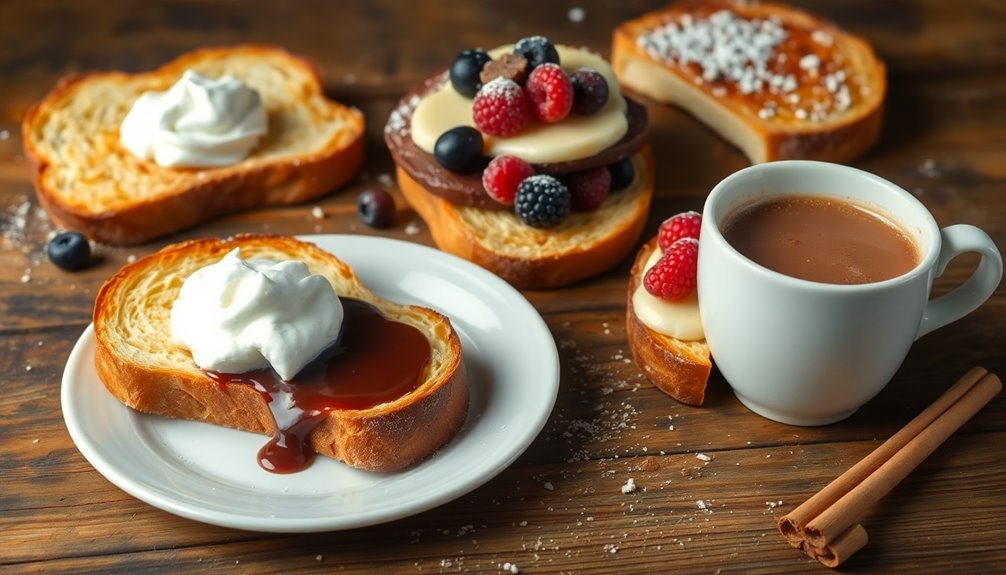
When it comes to comforting desserts, bread can be your secret ingredient for creating warm and inviting treats. One of the best ways to use a piece of stale bread is through classic bread pudding. This dish transforms leftover food into a creamy delight, blending eggs, milk, and sugar with your choice of fruits, nuts, or spices for added flavor. Additionally, using stale bread in desserts aligns with sustainable packaging solutions, as it minimizes food waste and promotes eco-friendly practices. By repurposing stale bread, you are also contributing to the circular economy, which emphasizes reusing resources.
If you're looking for something with a twist, try making a Cinnamon-Apple Brown Betty. Layer spiced apples with buttered bread for a cozy dessert that's perfect for sharing.
For a decadent option, whip up Butterscotch-Pecan Bread Pudding, which features a rich butterscotch drizzle and whipped cream—an indulgence you won't forget.
Don't forget about Banana Bread Pudding, which makes use of ripe bananas alongside that stale bread. It's a simple yet satisfying treat that's sure to please.
Finally, consider Chai-Spiced Bread Pudding to warm your soul with its aromatic spices. These comforting dessert options not only satisfy your sweet tooth but also help you minimize waste, so embrace the versatility of bread in your desserts! Additionally, using bread in desserts can also be a part of a broader strategy for financial literacy and resource management in your kitchen.
Hearty Main Dishes
When you're looking for filling meals, bread-based casseroles and strata can really hit the spot.
Think about layers of bread combined with savory ingredients for a hearty brunch or dinner.
You can even get creative by stuffing bread with your favorite fillings for a satisfying dish that pleases everyone.
Bread-Based Casseroles
Have you ever thought about how versatile stale bread can be in creating hearty casseroles?
Bread-based casseroles are the perfect way to turn leftover food into delicious main dishes that everyone will love. For instance, you can whip up a Ham & Swiss Bread Pudding, combining day-old bread with savory ham and cheese, serving up to 9 people.
Or, try the Mustard Ham Strata, which takes just about an hour to prepare and yields 12 servings—ideal for a satisfying brunch.
If you're looking for a comforting vegetarian option, the Savory Zucchini Bread Pudding mixes stale bread with zucchini and custard, serving another 12 people.
You can customize a Cheddar and Chorizo Strata using various cheeses and veggies, making it a flexible choice that can feed 8.
These recipes typically require a significant amount of bread—often around 20 cups—emphasizing the importance of using every slice to minimize waste.
Strata for Brunch
Strata makes an excellent choice for brunch, combining ease of preparation with the hearty flavors everyone craves.
It's a versatile dish that allows you to utilize leftover bread in a delicious way. You can whip up a classic Mustard Ham Strata or a Cheddar and Chorizo Strata, offering options for different tastes and dietary needs.
Here are a few reasons to love strata:
- Easy Prep: You can assemble the dish ahead of time, letting it sit in the fridge overnight.
- Customizable: Use whatever leftover bread, cheese, or veggies you have on hand.
- Feeds a Crowd: A single batch can serve up to 12 people, perfect for brunch gatherings.
With a cooking time of about 60 minutes, you can enjoy a hearty meal without spending all morning in the kitchen.
Plus, using day-old bread not only reduces waste but also enhances the strata's texture as it absorbs the custard mix beautifully.
Creative Stuffed Dishes
Transforming leftover bread into creative stuffed dishes provides a delicious way to minimize waste while enjoying hearty meals.
Start with stuffed bread bowls—hollow out those bread heels and fill them with your favorite soups or dips. This not only elevates the meal but also adds a rustic charm while cutting down on dishware.
Next, consider a savory bread stuffing. Combine the leftover bread with herbs, broth, and vegetables for a flavorful side dish, perfect for holiday gatherings or stuffed poultry.
For a filling main course, whip up a baked French toast casserole. Layer stale bread with custard, bake it, and you've got a sweet treat that's ideal for breakfast or brunch gatherings.
You can also stuff vegetables like bell peppers or zucchini with a mixture of day-old bread, spices, and cheese. This adds flavor and texture while reducing food waste.
With these creative stuffed dishes, you'll not only enjoy hearty meals but also make every slice of bread count.
Unique Health Uses
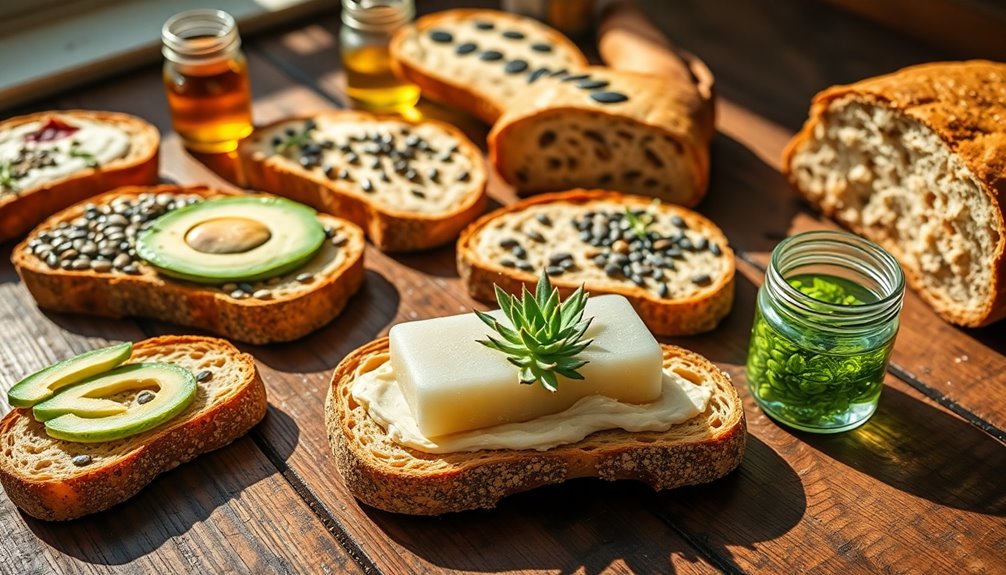
What if you could tap into the healing properties of bread beyond just a tasty sandwich? You can actually use bread soaked in various solutions for unique health benefits.
Here are some clever home remedies that might surprise you:
- Boils: Apply bread soaked in milk to a boil overnight. It helps draw out infection and promotes healing.
- Calluses and Corns: Tape bread soaked in apple cider vinegar to the affected area overnight. This method softens the skin effectively.
- Splinters: For an easy way to extract splinters, cover the area with milk-soaked bread. It's gentle and can aid in drawing them out.
While these uses can be effective, remember to always consult with a healthcare professional before using bread as a home remedy.
That way, you can ascertain safety and efficacy in whatever approach you choose.
Bread isn't just for meals; it can serve as a surprising ally in your health toolkit! So next time you have some leftover bread, think twice before tossing it out—you might just have a useful remedy at your fingertips!
Kitchen Tips With Bread
Bread often finds itself tossed aside when it gets stale, but you can regularly use it in clever kitchen hacks that maximize its potential.
For instance, if you want to soften hardened brown sugar, place a slice of bread in the container for 1-2 days. It'll restore moisture, keeping your sugar usable for baking.
You can also create delicious croutons by toasting leftover slices of bread in a skillet or oven with olive oil and seasonings. This adds a crunchy texture to salads and soups.
Transform stale bread into breadcrumbs by processing it in a food processor; these breadcrumbs work great as a coating for meats or in meatballs, enhancing moisture and texture.
Don't forget about bread heels! Use them as a spoon rest while cooking; they'll soak up extra sauce, minimizing mess and embracing the Italian tradition of "scarpetta."
Finally, make homemade bread chips by brushing slices of bread with oil and seasonings before baking until crisp. These chips make a healthy snack alternative, perfect for dipping into hummus or salsa.
Get creative and make the most of every slice!
Food Preservation Techniques
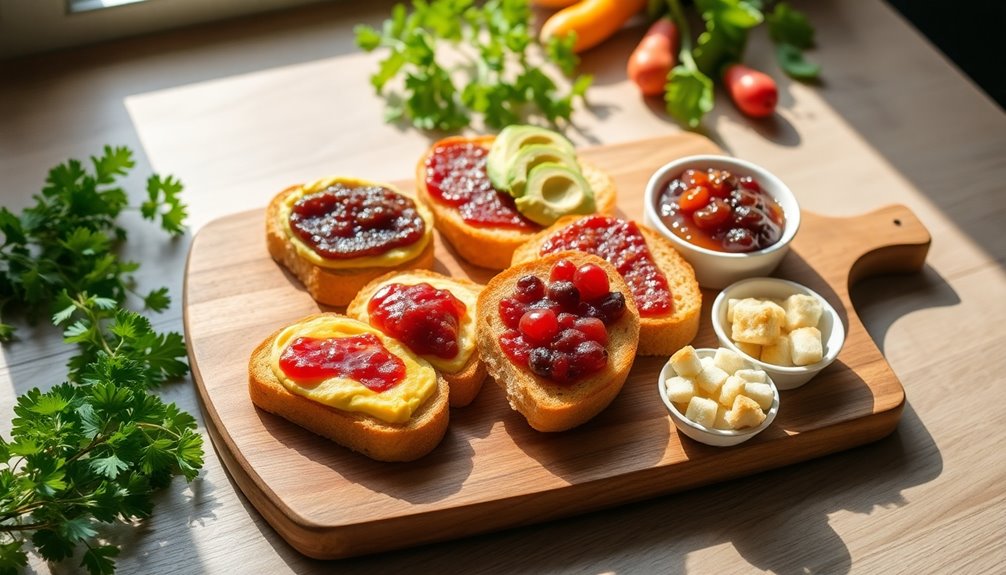
Preserving your bread guarantees you get the most out of every loaf, reducing waste and saving money. There are several effective techniques you can use to keep your leftover slices fresh and usable.
- Freeze it: Store leftover bread slices in airtight bags or containers. This method keeps them fresh for up to three months, allowing you to enjoy your bread later without compromising quality.
- Bread as a moisture keeper: If you've got hardened brown sugar, toss a slice of bread into the container for 1-2 days. The moisture from the bread softens the sugar without risking mold growth.
- Make breadcrumbs: Transform stale bread into breadcrumbs using a food processor. Store them in airtight containers for up to six months, providing a versatile ingredient for your cooking adventures.
Additionally, store your bread in a cool, dry place, ideally using a bread box or cloth bag. This maintains moisture levels and prevents staleness.
Cleaning Hacks With Bread
You might be surprised to learn that bread can double as an effective cleaning tool around your home. Soft bread is surprisingly versatile and can tackle various messes with ease.
For instance, if you accidentally break a glass, use a piece of soft bread to carefully pick up those tiny shards. It's a handy tool for safely cleaning up kitchen breakages.
If you own oil paintings, you can gently remove dust with a piece of soft bread, which absorbs dirt without damaging the artwork. Additionally, bread serves as a non-abrasive cleaning option for your painted walls. Simply rub it over smudges, and watch them disappear.
Suede items can also benefit from this unconventional cleaning trick. Use soft bread to remove smudges and dirt, ensuring you don't harm the delicate fabric.
Furthermore, if you have greasy spills, a piece of bread can soak up excess grease, making it a practical choice for both cooking and cleaning tasks.
Next time you find yourself in need of a quick cleaning solution, don't overlook your loaf of bread! It's a frugal, effective way to keep your home spotless.
Community Tips and Tricks
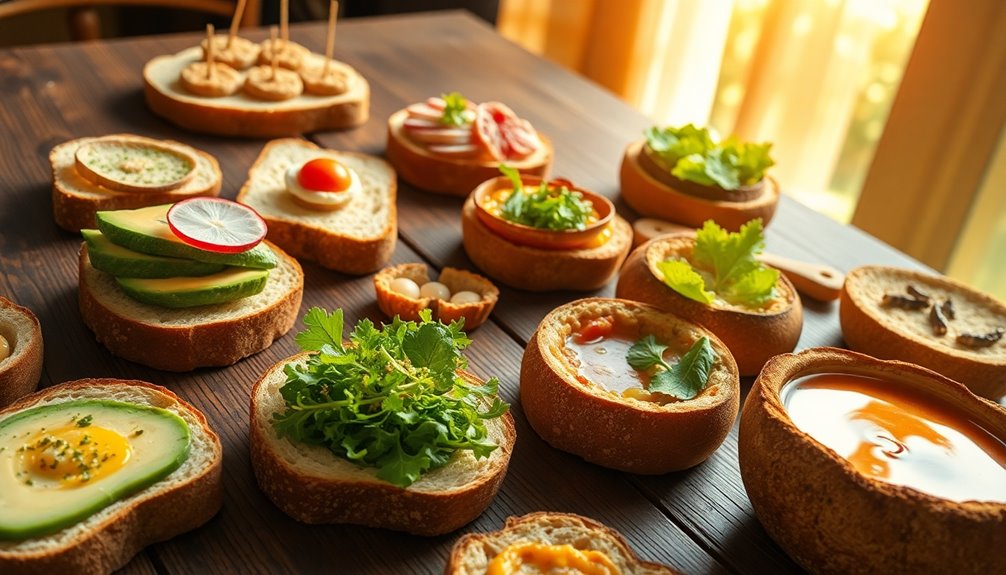
When it comes to making the most of leftover bread, community members have plenty of creative tips and tricks to share. By engaging with your neighbors, you can discover innovative ways to repurpose stale bread that not only reduce waste but also enhance your meals.
Here are some popular ideas:
- Homemade croutons: Cube stale bread, toss it with olive oil and your favorite seasonings, then bake until crunchy. They're perfect for adding texture to soups and salads.
- Bread pudding: A comforting dessert that transforms stale bread into a delicious treat. Mix it with eggs, milk, sugar, and any add-ins like raisins or chocolate for a family favorite.
- Breadcrumbs: Use your food processor to turn leftover bread into breadcrumbs for cooking or baking. They're great for coating chicken, adding to meatballs, or topping casseroles.
These community-driven strategies foster a sense of camaraderie while promoting frugal living.
Environmental Benefits of Reducing Waste
Reducing food waste, particularly bread, offers significant environmental benefits that can't be overlooked. By cutting down on the amount of bread you throw away, you help decrease greenhouse gas emissions, which account for about 8-10% of global emissions.
The USDA highlights that 30-40% of the food supply in the U.S. is wasted, revealing a huge opportunity for improvement.
Repurposing bread not only minimizes waste but also conserves precious resources. Producing just one pound of wheat requires around 1,800 gallons of water, most of which goes to waste alongside unused bread.
When discarded bread ends up in landfills, it generates methane, a greenhouse gas that traps heat 25 times more effectively than carbon dioxide.
Conclusion
By embracing these creative ways to use every slice of bread, you're not just saving money; you're also crafting delicious meals and reducing waste. Picture a cozy morning, flipping French toast while a savory strata bakes in the oven. Imagine turning stale bread into a comforting pudding, all while enjoying a fresh salad on the side. Each slice becomes a tool for innovation, showing that with a little creativity, you can transform leftovers into culinary treasures for your table.

